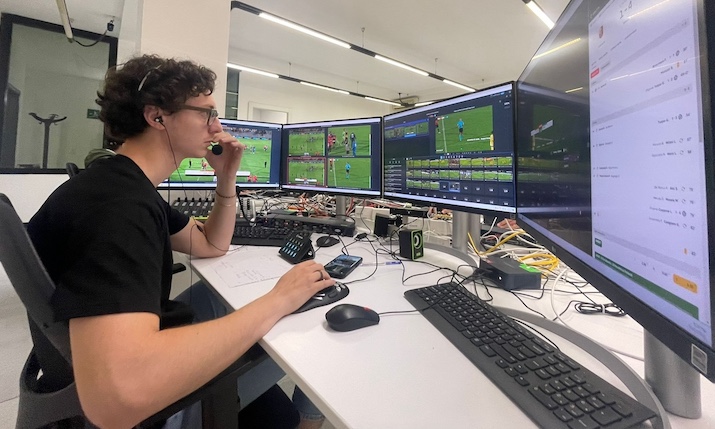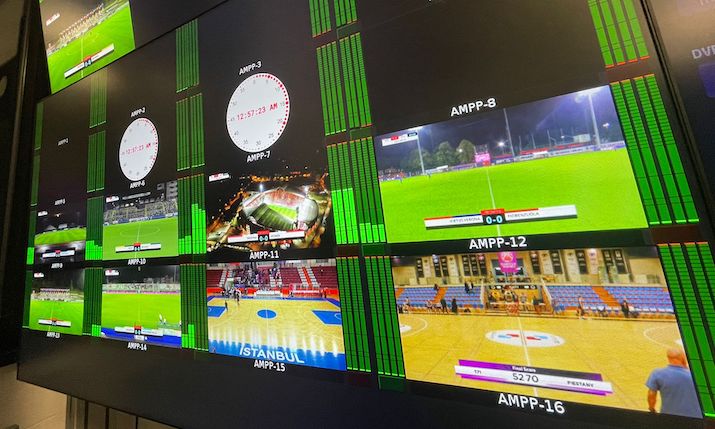Serie C grows in quality and reach as NVP implements remote production set up

Following its success with Serie B last season, governing body Lega Pro has again worked with NVP to establish a remote production setup for Serie C, the third division of Italian football, for matches broadcast on Sky Italy.
Ivan Pintabona, technical manager of NVP, says: “This is a project that has revolutionised the way football matches are produced, launched by Lega Pro, with the support of NVP. Since September 2023, all Serie C matches have been broadcast live from our Innovation Hub located in Cologno Monzese, in the province of Milan, managed by our subsidiary HiWay Media. The production centre is equipped with state-of-the-art equipment that allows us to control all phases of production remotely and send only two cameras, two operators and some encoders to the field.”
AMPP in the cloud
During the current season, which started on 1 September and runs until April, around 1,100 football matches will be produced remotely, with 30 matches played every weekend. To enable this, NVP and HiWay Media will be using Grass Valley AMPP technology.
Some 160 matches were produced in September alone. Ahead of such an extensive operation, NVP had to evaluate each stadium to understand what type of connectivity was available and what needed to be integrated. It was then deemed necessary to use a mix of low-orbit satellites and fibre, in order to have as much bandwidth as possible.
The decision to move to a remote production setup is also notable as it’s the first year that Serie C is being aired on Sky Italy, and therefore a much higher quality is required than in previous seasons.
“This is true both in terms of production and graphics and for encoding. We are using a new generation of encoders that, placed in the stadiums, transport the signals thanks to more efficient encodings that exploit the available bandwidth in a better way,” Pintabona adds.
Standards and codecs
Serie C is produced with 1080i 50 standard images and stereo audio, with the intention of transitioning to progressive signals in the near future, for which the entire infrastructure is ready. Encoders from Haivision are used in the stadiums. For delivery, Grass Valley encoders are employed: a virtual OB van directs and receives signals from the stadiums, processes them and then re-encodes them for delivery.
“We have devised a model suitable for this type of production,” says Pintabona, “all enabled by AMPP and its usage methods. It is possible for the director to be in Cologno while the production gallery is in Berlin. The management part is very user-friendly, and the production interfaces are web-style home pages. The signals are transported according to the workflow studied in the alignment phase and delivered to the gallery for the production phase.
“With Serie B, we became aware of the limits and merits of remote production, eventually becoming a driving force and a testbed for Grass Valley and subsequent developments. The highlights and delivery elements for users and third-party takers is immediate, as content can be moved to an S3 network, positioning it on very fast access systems. An interesting system of automation allows us, even just five minutes after the end of the match, to make highlights available in each individual’s private folder.”

Three production standards have been agreed by Lega Pro and Serie C. The typical remote production setup requires two-camera shots from each stadium. The second and third standards include the presence of a mobile vehicle at the stadium. The second standard is used for the two or three top matches every weekend and includes five cameras. The third standard provides for six cameras, plus a drone, coming very close to the standards of Serie B.
Even the top matches, managed by mobile production on site, are still controlled by Grass Valley AMPP systems, including graphics and slow motion. The signals arrive from each stadium at one of the galleries in Cologno Monzese where a producer has all the classic functions of television shots, from replays to the insertion of graphics.
This year also sees the integration of data: the graphics, managed as a service in the cloud, are created in HTML5 and have been connected to the stats setup. A single international feed is produced for Sky along with two for international takers and other private broadcasters authorised by Lega Pro: therefore, usually, three or four feeds are delivered with different in audio.
The commentator has the option to be physically present at the match, and their audio signal is transported on the camera signals.
An innovative workflow
“We have created and tested the workflow and the entire Serie C system,” continues Pintabona, “building on the extensive know-how we derived from the previous season and the remote production of Serie B. The differences largely depend on the different budgets and cameras used. Central to all of this is Grass Valley AMPP technology, which utilises predictive encoding to ensure high quality with minimal bandwidth usage. The AMPP production gallery is tailored to our actual needs, with adequate computing power, while maintaining high signal quality.
“I would say that there are many situations that allow for cost savings and optimisations, and we have demonstrated that this ‘initial’ level still significantly enhances the quality of TV production, enabling us to broadcast on Sky.”
A significant effort
Behind a production of this kind, there is, of course, considerable effort. “Remote production must apply the highest level of technological innovation within a specific budget and, therefore, using a different approach is not feasible,” he adds. “It is likely the only way, given the number of matches, the challenges of covering 60 stadiums across Italy, uncertain connectivity and various other variables. The contract was awarded to NVP, which provided the remote production know-how – with the support of HiWay Media – the associated digital delivery, streaming signal delivery and MCR expertise. Comintek MPP followed the production carried out with the crews and OB vans in the field.”
“We managed to set up the system in record time,” concludes Pintabona, “thanks to our previous experience with Serie B. We entered a completely different world, but having leveraged that previous experience and made it a model that we were able to replicate according to requirements, and now with Serie C.”

